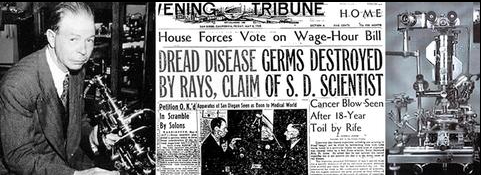Why are Frequency Generators also called Rife Machines?
Much of the credit for frequency generator type electronics is given to the geniuses Nikola Tesla and Royal Raymond Rife due to discoveries and research that originated from their life’s work. Because of Rife’s high powered microscopes that gave him more vision and his electric ray machine that killed disease causing pathogens, he brought Tesla’s discoveries to life. Many people refer to any device that applies specific electrical frequencies to improve mammalian health as Rife machines.
Rife technology is a derivation of wellness electronics technology first developed by Nikola Tesla over 130 years ago which he found of beneficial use on himself. Tesla went on to write in 1894 that medical men should investigate this phenomenon further.
Royal Raymond Rife was a pioneer that expanded on this understanding and opportunity. Through his high powered microscopes, he researched what specific frequencies would be needed to eliminate various toxins or viruses, parasites and bacteria. He watched harmful organisms completely disintegrate or die when specific electric frequencies were applied which he called their mortal oscillatory rate. He believed he could apply these various frequencies to kill disease causing toxins that lived within the body.
Royal Raymond Rife found that cancer was a virus and conducted experiments on 16 terminal cancer patients. According to some claims, the machine he developed using specific EMFs (Electromagnetic Frequencies) cured 14 of the patients, and the other two stayed for more intensive treatments. Four weeks later, the other two were reported to be cured.
In 1938, clinics with Rife’s technology were opened in San Diego, Los Angeles and Pasadena, California. Phenomenal results were reported. A special Medical Research Committee was organized at the University of Southern California in Los Angeles to oversee and manage Royal Raymond Rife’s “energy medicine” research and review clinical outcomes from a variety of disease conditions including cancer. The term “Rife machine” for frequency generators was really born from his research and successful approach at targeting parasites, bacteria and viruses with a specific frequency.
While Tesla and Rife are the most famous for this technology, there have been many others who have made discoveries throughout history. Here’s a chronology of discoveries throughout the centuries and around the world that has led to electrotherapy becoming more widely available today:
46 AD (Ancient Rome) - Scribonius Largus discovers the electrical discharge of aquatic animals and describes the use of torpedo fish for medical applications.
1600 (England) - William Gilbert, the physician to Queen Elizabeth, published a book that describes the use of electricity in medicine called De Magnete. His work considered static electricity produced by amber. Amber is called elektron in Greek, and electrum in Latin, so Gilbert coins the name of the phenomenon by the adjective ‘electricus’ or ‘electricity’.
1743 (Germany) - Krueger, a professor of medicine, suggests in lectures that safe levels of electricity might be used in the treatment of paralysis.
1745 (Germany) - Kratzenstein publishes a book on electrotherapy. He details a method of treatment that includes electrifying the patient with a large revolving frictional glass globe.
1780 (Italy) - Galvani, Professor of Anatomy at the University of Bologna, first observes the twitching of muscles under the influence of electricity. Galvani then proves that atmospheric electricity, as is manifested in lightning, will produce the same effects on muscular movement.
1800 (Italy) - Carlo Matteeucci shows that injured tissue generates electric current.
1840 (England) - England’s first electrical therapy department was established at Guy’s Hospital, under Dr. Golding Bird. The electrical discovery of Galvani leads to the use of mechanically pulsed Galvanic current.
1860 (England) - Bristow develops the Brisow Coil, using Faraday’s principle of electro-magnetically controlling the voltage of electricity. This is the start of Faradic Stimulation.
1891 (USA) - Nikola Tesla presenta a paper in ‘Electrical Engineer’, about the medical application of high frequency currents. He notes that when the body is transversed by alternating currents above a certain frequency, physiological changes such as heat are perceived. He asks the medical community to investigate the health benefits of frequency currents in humans further.
1891 (France) - D’Arsonval, in a communication to the Societe de Biologie, shows that a high frequency current (Greater than 10,000 Hz) can be passed through the body without producing any sensation other than heat. D’Arsonval demonstrates the ability of high frequency currents to modify physiological processes, including: respiratory exchange, dilation of peripheral blood vessels, arterial blood pressure.
1900 (Worldwide) - The electrical discoveries of Glavano, Faraday and Tesla were therapeutically adopted by activating the electrical phenomena of the human body with the use of Galvanic, Sinusoidal, and Faradic currents. These become the standard methods of applying Electrical Body Stimulation. There becomes a preference to utilize the more comfortable and less hazardous Faraday method.
1908 (Germany) - Von Berndt, Von Priess and Von Zeyneck publish a paper on the treatment of joint disease by high frequency currents.
1929 (Russia) - Lakhovsky publishes his book “The Secret of Life” with his studies that conclude that cells possess resistance, capacitance, and inductance and function like tuned resonant circuits, capable of resonating to a resonant frequency when exposed to a range of frequencies.
1930’s (Germany) - Interferential currents are developed. Two alternating, medium frequency sine wave current paths are crossed to give pulsed low frequency modes of electrical stimulation. Interferential currents are much more comfortable than anything else available at the time.
1934 (USA) - Royal Raymond Rife conducted experiments on 16 terminal cancer patients. According to some claims, the machine he developed using specific EMFs (Electromagnetic Frequencies) cured 14 of the patients, and the other two stayed for more intensive treatments. Four weeks later, the other two were reported to be cured.
1938 (USA) - Clinics were opened in San Diego, Los Angeles and Pasadena, California. Phenomenal results are reported. A special Medical Research Committee is organized at the University of Southern California in Los Angeles to oversee and manage Royal Raymond Rife’s “energy medicine” research and clinical success with a variety of disease conditions including cancer. The term “Rife machine” for frequency generators was born from his research and approach at targeting parasites, bacteria and viruses with a specific frequency.
1950’s - 1990’s (Russia) - ‘Russian Stimulation’ is developed - 4,000Hz tone bursts, 50% ON, 50% OFF, alternating currents with 50 tone bursts per second. This is used by athletes for building muscle and increasing power.
1970’s (USA) - Transcutaneous Electrical Nerve Stimulation (TENS) is acknowledged as a viable method of pain management by America’s Food and Drug Administration (FDA). Many American companies begin production of TENS devices. The heart pacemaker is developed.
1970’s (England & Canada) - Melzak and Wall propose the ‘Pain Control Gate’ theory, by which strong afferent nerve stimulation by chemical, mechanical or electrical means overrides painful sensations at hypothetical pain control ‘gates’ in the spinal cord.
1970’s & 80’s (Sweden) - Clinical researchers Ericsson and Sjolund publish a series of articles in various scientific and medical journals. They compare constant, high frequency TENS to bursts of high frequency TENS (termed acupuncture-like TENS), finding that the latter offers better pain relief and does in fact instigate a release of endorphins into the bloodstream.
1981 (USA) - Dr. Robert Becker publishes “The Body Electric”. Challenges the established mechanistic understanding of the human body. Finds clues to the healing process and proposes the theory that electricity is vital to life.
1991 (Germany) - Nobel Prize recipients Erwin Neher and Bert Sakmann developed a technique that detects electrical currents of a trillionth of an Ampere in the membranes of the cell, establishing the existence of ion channels in the body.
1997 (USA) - Global Wellness frequency generator is designed and funded by the nonprofit USMRF and manufactured in the USA. The goal was to make the technology accessible and easy to use to bring frequency generators into homes. This design became one of the most popular Rife machine units sold globally.
2000 (USA) - John McDonald of Washington University uses intensive applications of Electrical Muscle Stimulation (EMS) to exercise the muscles of a quadriplegic of 8 years. The patient defies medical science by regaining limited sensation and movement in his body. The regimen includes 2 hours of EMS and hydrotherapy weekly.
2003 (USA) - NASA releases results of a 4-year study that showed conclusively that lower frequencies were ideal for stimulating cell growth, repair and healing. The study also concluded, “The most effective electromagnetic field for repair of trauma was the squarewave with a rapid rate of change, which saw cell growth increased up to 4.0 times.”
Today (Globally) - There are various manufacturers that offer frequency generators or Rife machines for health and wellness. The Wave Therapy frequency generator machine has roots with Rife technology pioneers that have designed and manufactured frequency generators for over twenty years.


